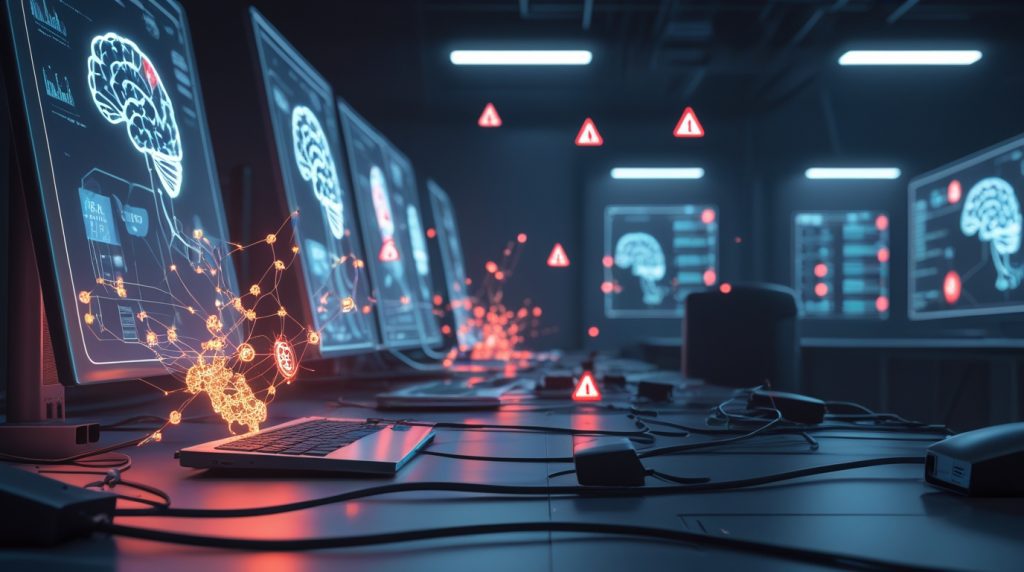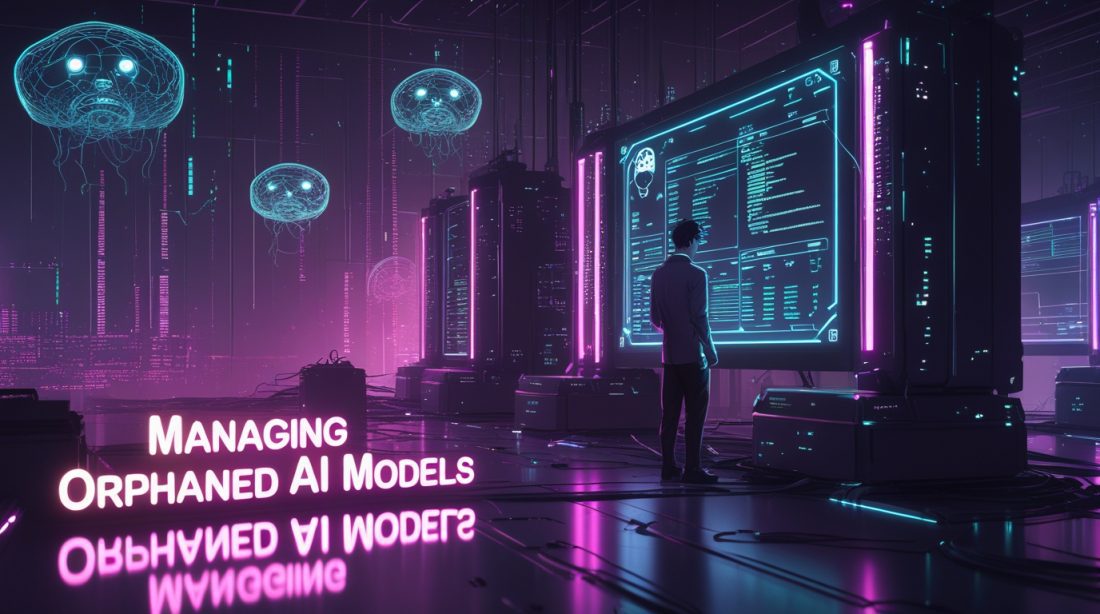A single unmaintained algorithm can quietly drain millions from your bottom line.
In a corner of your company’s digital infrastructure, a once-cutting-edge AI model continues to make decisions. The team that built it has moved on, the documentation is outdated, and its performance slowly degrades. Meanwhile, it still influences critical business operations. This isn’t speculative fiction—it’s the reality of managing orphaned AI models, a growing and costly challenge for industrial AI implementations.
As one technical observer noted, “It starts quietly. An API call returns an error. A GitHub issue goes unanswered for months. A once-famous model hailed as a breakthrough stops getting updates. Somewhere on a forgotten server, its neural weights sit untouched”. This creeping problem of AI orphans represents one of the most significant unaddressed risks in enterprise AI today.
What Are Orphaned AI Models and Why Do They Matter?
Orphaned AI models are trained machine learning models that have lost their maintainers—the original engineers, data scientists, and teams who understood their intricacies and kept them performing optimally . They’re not merely “old software”; they’re expensive digital assets that have entered a state of limbo, often without clear ownership or maintenance protocols.
The reason this matters in 2025 is simple: scale. Companies that embraced AI early are now discovering that the models they deployed two or three years ago remain in production, often embedded in critical business processes. The teams that built them may have disbanded, moved to new projects, or left the organization entirely. What remains are algorithmic ghosts in the machine—still active but increasingly misunderstood and potentially hazardous.
Industry approaches to this problem vary widely. Some providers, like Anthropic, have begun committing to preserving weights for models with significant use, recognizing that “turning systems off can carry real costs and new safety questions” . Meanwhile, AWS and Azure have implemented model lifecycle policies labeling models as Active, Legacy, or End-of-Life with minimum twelve-month runways . But these provider-level solutions don’t address the custom models developed in-house.
The Silent Growth of Your AI Orphan Population
Orphaned models manifest in several forms across organizations:
- Open-source models without owners – Early implementations of BERT variants or other architectures whose repos haven’t been updated in years
- Corporate casualties – Chatbots or vision APIs discontinued with little warning as corporate strategy shifts
- Academic ghosts – Models described in research papers but never properly productionized or maintained
- Integration dependencies – Models embedded in larger systems where their presence is almost forgotten until they fail
The table below outlines common orphan scenarios and their triggers:
| Orphan Type | Typical Trigger | Enterprise Impact |
|---|---|---|
| Open-Source Without Owners | Community maintenance ends; original contributors move on | Technical debt accumulation; security vulnerabilities |
| Corporate Casualties | Strategic pivots; acquisitions; budget reallocations | Broken workflows; operational disruptions |
| Academic Ghosts | Research projects never productionized | Wasted R&D investment; reproducibility issues |
| Legacy Dependencies | Organizational restructuring; team turnover | Performance degradation; compliance risks |
Consider what happened at one enterprise: an investigation into rapid database growth revealed “more than 300 thousand orphaned Attachment Document records and daily increasing” created by an automated process . The created-by field showed “sharedservice.worker”—a Predictive Intelligence service—but cascade delete wasn’t properly configured in the table cleaner, creating massive data bloat . This illustrates how orphaned AI artifacts can accumulate quietly, consuming resources and creating technical debt.
Why Orphaned Models Create Critical Business Risks

The Compliance Time Bomb
In regulated industries, model changes trigger compliance reevaluations. As noted in analysis of AI governance, “model changes can trigger the need to re-evaluate models for compliance in regulated use cases. This might mean continuous need for policy updates, re-testing, and approvals” . Orphaned models represent a particular compliance nightmare—who maintains the documentation for auditors when the original team is gone?
The regulatory landscape is formalizing these concerns. The newly published ISO/IEC 42005:2025 standard establishes AI impact assessment as an ongoing requirement throughout the AI lifecycle, not just a one-time pre-deployment checkbox. This means organizations can be cited for inadequate maintenance of production models, regardless of whether the original team remains intact.
Performance Degradation and Model Drift
All models degrade. The business environment changes, user behavior evolves, and the patterns the model learned during training become less representative of current reality. One analysis of the AI lifecycle notes that “continuous monitoring and maintenance are essential to prevent model drift and ensure AI models remain accurate and reliable in real-world environments” .
With orphaned models, this monitoring often falls through the cracks. There’s no clear owner to notice when accuracy metrics slip or when inference times slow. The model continues operating, making increasingly poor decisions and potentially automating outdated business logic.
“When a baseline model disappears, experiments and audits lose a stable reference. Even small deltas in model behavior can change model outcomes” . This observation from industry analysis highlights how subtle changes in orphaned models can ripple through dependent systems.
Security Vulnerabilities and Attack Surfaces
Unmaintained models represent expanding attack surfaces. As one industry report notes, “Model moderation or security platforms that aim to prevent prompt-injection or model tainting could potentially require redevelopment when new models expose new prompt-injection surfaces” . Orphaned models don’t receive these security updates, leaving them vulnerable to emerging threats.
The security concern extends beyond the models themselves to their supporting infrastructure. Dependencies become outdated, containers aren’t patched, and API endpoints lack proper security reviews. What was secure when deployed may now be vulnerable.
Why Engineering Teams Abandon AI Models
The AI Talent Churn
The competition for AI talent remains fierce, with turnover rates significantly higher than in other IT domains. When a senior data scientist leaves, they often take irreplaceable knowledge about model quirks, training data peculiarities, and integration nuances. The remaining team members may lack the context or bandwidth to properly maintain all existing models.
Shiny Object Syndrome
The AI field moves rapidly, with new architectures, techniques, and capabilities emerging constantly. This creates powerful incentives for teams to chase the next breakthrough rather than maintain existing implementations. As one engineer at a financial services company shared (fictional anecdote), “We built a perfectly serviceable fraud detection model two years ago, but when transformer-based approaches emerged, the entire team pivoted to the new technology. Nobody wanted to be stuck maintaining the ‘legacy’ system.”
Missing Model Retirement Protocols
Most organizations lack formal processes for model decommissioning. The AI lifecycle typically receives meticulous attention during development and deployment, but rarely includes clear end-of-life protocols. Without standardized retirement processes, models continue running indefinitely, regardless of their current business value or technical condition.
The Maintenance Resource Gap
Model maintenance is less glamorous than model development but often more resource-intensive. One analysis of engineering trends notes that “successful deployment isn’t just about making the model available: it involves robust LLMOps strategies to continuously monitor, update, and refine the model to prevent degradation over time” . Many organizations underestimate these ongoing requirements during initial project planning.
How to Identify and Inventory Orphaned Models

Conduct an AI Asset Census
Start by identifying all models in production, including those embedded in larger applications or automated processes. The inventory should capture:
- Original business purpose and owner
- Current performance metrics and monitoring
- Dependencies and integrated systems
- Documentation status and quality
- Maintenance history and team assignments
Implement Model Monitoring and Alerting
Continuous monitoring provides the data needed to identify potential orphans. Track:
- Performance metrics: Accuracy, precision, recall against current business requirements
- Technical metrics: Latency, throughput, error rates, resource consumption
- Business metrics: Impact on key business indicators, ROI calculation
- Data metrics: Feature distribution drift, concept drift, data quality issues
Models showing degraded performance with no responsive maintenance team are likely orphans.
Assess Organizational Awareness
Conduct interviews with business unit leaders, IT teams, and remaining data science staff. Models that nobody claims or understands are strong orphan candidates. Pay particular attention to models described as “black boxes” or where the original developers have departed.
Solutions for Managing Orphaned AI Models in Enterprise Environments
Establish Formal Model Governance
The ISO 42005 standard provides a framework for continuous impact assessment throughout the AI lifecycle . Implementing this approach means:
- Assigning clear ownership and accountability for each model
- Establishing regular review cycles and maintenance schedules
- Creating formal decommissioning criteria and processes
- Maintaining comprehensive documentation and version control
Implement Model Lifecycle Management
Treat models as managed assets with defined lifecycles:
- Development phase: Requirements, design, training, validation
- Production phase: Deployment, monitoring, maintenance, updates
- Sunset phase: Feature reduction, user notification, shutdown
- Archival phase: Model preservation, documentation, potential reactivation
Amazon Bedrock’s approach of labeling models as Active, Legacy, or End-of-Life with minimum twelve-month runways provides a useful template .
Create Maintenance-Oriented Team Structures
Address the human element through:
- Dedicated maintenance rotations where engineers periodically focus on existing models
- Knowledge transfer protocols requiring documentation before team members transition
- Cross-functional stewardship with both technical and business owners for critical models
- Maintenance metrics that reward engineers for sustaining long-term model health
The Future of Model Stewardship

As AI becomes more embedded in enterprise operations, the problem of model orphaning will intensify. The organizations that thrive will be those that recognize model maintenance as a core competency rather than an afterthought.
Industry practices are evolving toward greater responsibility. As Anthropic’s research note observes, providers are beginning to recognize that “retiring past models is currently necessary for making new models available and advancing the frontier, because the cost and complexity to keep models available publicly for inference scales roughly linearly with the number of models we serve” . This tension between progress and preservation will define the next era of industrial AI.
The question is no longer whether your organization has orphaned models, but how many, and what risks they represent. The time to find them is now—before they find you.
FAQ
What are the first signs of an orphaned AI model?
Early indicators include performance degradation without investigation, failed API calls with no response team, outdated documentation, and difficulty identifying who’s responsible for maintenance. Technical debt accumulation around the model is another red flag.
How does model orphaning affect ROI on AI investments?
Orphaned models continue to incur compute, storage, and indirect costs while delivering diminishing business value. This erodes the return on initial development investment and can eventually create net negative value through poor decisions or operational disruptions.
What industries are most vulnerable to model orphaning?
Highly regulated industries (finance, healthcare) face greater compliance risks, while organizations with rapid AI adoption cycles and high technical staff turnover are particularly susceptible to accumulation of unmaintained models.
How does ISO/IEC 42005 address model orphaning?
The standard makes impact assessment an ongoing requirement throughout the AI lifecycle, forcing organizations to maintain stewardship rather than treating assessment as a one-time pre-deployment activity.
Fast Facts
Managing orphaned AI models is emerging as a critical enterprise risk in 2025. These unmaintained systems—often forgotten after deployment—can quietly degrade performance, introduce compliance issues, and expose security vulnerabilities. As AI adoption scales, organizations must implement formal governance, continuous monitoring, and retirement protocols to prevent costly technical debt and operational disruptions.
Subscribe to Our Newsletter
Want monthly analysis of industrial AI implementation challenges? Get practical insights on managing model lifecycles, preventing technical debt, and maximizing ROI from your AI investments.
Further Reading & Related Insights
- 7 Reasons Why Industrial AI Ghosting Is Costing Manufacturers Millions in 2025 → Explores how neglected AI systems silently erode ROI and operational stability—perfect companion to orphaned model risks.
- AWS Outage Robotics: How the 2025 Cloud Failure Exposed the Fragility of Global Automation → Highlights infrastructure dependencies and how unmonitored systems can collapse under stress.
- AI Cloud Ingestion Fees: 5 Alarming Reasons Small Factories Face AI Data Cost Fatigue → Adds context to the hidden costs of maintaining legacy AI systems and data pipelines.
- How Stakeholder Fear Kills AI Retraining Budgets Mid-Cycle → Explains why many models go unmaintained due to internal resistance and budget misalignment.
- Solving the Legacy PLC AI Bottleneck in Industry → Tackles the challenge of integrating and maintaining older AI systems within evolving industrial stacks.

